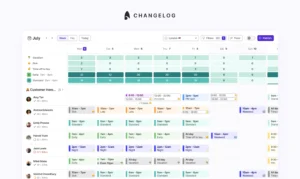
Industry Interview: Luba Chudnovets, Co-Founder at Cordless and ex Head of Scaling Operations at Monzo

Prior to starting Cordless, Luba was Head of Scaling Operations at Monzo where building out processes for the customer service team was both a challenge and an enormous opportunity for Monzo to succeed in their mission of making money work for everyone. Monzo serves over 4 million customers with a team of c. 1,600 people.
In December 2018, Luba wrote an insightful and honest blog post “Why we made a mistake with customer support (and how we fixed it)” attributing poor customer service to not investing enough in forecasting and the challenges of hiring at scale.
Solving these problems is what Surfboard sets out to do, enabling customer service teams to delight customers with quick response times by having their team in the right place at the right time. Our core set of customers are rapidly growing companies offering customers multiple channels to get in touch. This means we use a more nuanced and sophisticated approach to forecasting and scheduling than simply using historical data.
How did you get involved with Monzo’s customer service team?
I joined Monzo as a business analyst after spending a couple of years in management consulting. At Monzo I worked on other projects at first but when CS became the most important thing for us to get right, everyone was thrown at the problem and they needed more firepower at all fronts.
We reached the size of about 40 Cops at this point (Customer operations), began having our first issues with individual performance and needed to introduce more structure and processes into how the team was managed.
At about the same time we had an outage, which led to a big demand spike that we couldn’t handle. To help us clear the backlog we decided to engage an outsourcing agency for the first time, adding more complexity to planning.
I joined the team first to help build out some more formal processes and project manage selected improvements. I later took on a leadership position as a Head of Scaling, a team that was exclusively focused on supporting Frontline Cops, building processes around hiring, training and scheduling.
How was Monzo’s customer service team structured?
At the time of the blogpost at the end of 2018, our biggest and most core team were the Frontline Cops supported by Cops managers. Banking requires deep knowledge of specific topics, so we also had specialist teams focusing on areas like financial crime and lending. The team was about 300 people. On average one team lead managed 6-7 Cops.
We also had a Scaling team that looked after Hiring and Training, Forecasting and Scheduling and 2 product teams: FAQs and our Internal Cops Product to improve the velocity of the team.
We had chat, email and phone available 24/7.
What were the biggest challenges you encountered in scaling the CX team?
Having the right number of knowledgeable people available to answer customers’ questions was definitely one of the biggest challenges. Forecasting is really hard when the business is growing quickly. Training people was a challenge too. More than 50% of your team had joined in the last 6 months and the product was constantly evolving, requiring ongoing retraining.
Building the management structure within the Cops team was super hard too. Monzo culture was very distinct, so we had trouble hiring from outside, but the leaders we promoted from within were not very experienced, myself included. A lot of the things we were doing was trial and error.
You mentioned in your blogpost that not investing enough in forecasting was a root cause of delivering customer service that wasn’t up to scratch. Can you tell us more about why accurate forecasting is important and the downstream effects of not forecasting properly?
If you don’t forecast properly 2 situations can happen either you over-hire or you under-hire. You always operate within a certain margin, but if you go too far, it is expensive for the business.
- If you significantly over-hire, i.e. you have more Cops than you need – it is more costly for the business than it needs to be. It’s also not great for Cops’ morale, because it’s important for every person to feel like they are having a positive impact. You can potentially cut your team, but again this is costly (you spent time hiring these people) and your team will not be happy about this. It’s possible the growth in the business will catch up with your team though making it important to have a long-term view on this and not make decisions on a whim.
- On the other hand if you under-hire, i.e. you don’t have enough people – customers will have to wait longer, which depending on the business might be critical to their experience of your product. If you don’t fix it, it will most definitely have an impact on your retention and revenue. It’s a terrible experience for agents too, because it puts them under a lot of pressure. The team might feel like they are not doing a good job and get really stressed as they see the queues growing, affecting retention of the team.
So to sum up, in both cases it has a very real financial impact on the business, customer happiness and the well-being of the employees.
For a business like Monzo, what makes forecasting difficult?
I think this is a challenge for any high growth business. There are a lot of unknowns and you have to make your best guess for your core assumptions:
- You don’t know how many customers you will have in 3 months time
- You don’t know how frequently they would get in touch, because you don’t really know where the product will be. Would it be more complex or actually you would be able to fix those bugs that customers are getting in touch about? To use a specific example, when we moved from a prepaid card to a current account, this created a forecasting issue for us as these products were extremely different in the types of reasons customers would get in touch. As we fixed some of the issues of the current account, we ended up overhiring, costing the business unnecessary sums.
- You are always in a situation where more than 50% of your team joined less than 6 months ago, so team productivity is really variable and unknown.
All of these factors contribute to a lot of uncertainty when forecasting. But hiring takes several months to catch up. So you can find yourself in really hairy situations for a while, which we did at the end of 2018.
What do you think the most important thing is in making customer service a success?
It’s hard to pick one thing – there is a lot that goes into it. I would say that to make CS a success, it has to be at the front of mind for everyone in the company including everyone in the senior leadership. CS is not an isolated part of the company and is never static.
To give you a very specific example – if product managers think through the impact and trade off that releasing products might have on customers and CS team, it will result in better outcomes for the business by looping in CS early and not overwhelming the team at a suboptimal time.
In ops everything changes all the time, so you constantly need to think about what will happen in 6 months time and how to prepare the team for it. This is a company-wide exercise.
At Cordless, you’re building tools to manage unexpected call peaks. Can you tell us more about how this works and how it will fundamentally change customer service?
At Cordless we are building a new platform for voice support. In addition to everything you would expect a voice support platform to do – like taking and making calls, we are building in several important tools.
Firstly, with Cordless companies can now support calls asynchronously. Instead of waiting on the line, customers would have an option to pick a time for a call and leave information about their question, so that a CS agent can call them back with context. It is great for CS teams too, because it would allow them to smooth out the demand peaks and prepare for the call upfront to reduce the stress of supporting calls.
Secondly, when an unexpected peak happens (for example, an outage), on Cordless you would be able to update your IVR settings in minutes including sending messages to customers with up to date information automatically if they call. You can save that ‘on fire’ set up too in case you need it for the future.
And thirdly, while this is less related to forecasting, but definitely super relevant for a great customer service setup, Cordless has built-in voice analytics to make voice content searchable, easy to categorise and document. This makes so many things easier for CS teams – QA of calls, understanding customer feedback and compliance. It replaces the time consuming process of listening calls and makes voice a medium you can finally work with.
Overall we at Cordless believe this would dramatically improve customer experience and reduce cost of supporting calls.
Finally, can you tell us about one company whose customer service you admire?
Apple.
You never need to wait in line. They give you a call back and send you helpful updates while you are getting on with your life. On top of that, they authenticate customers within seconds using biometrics instead of quizzing them about their personal details.
The most customer centric companies strive for this kind of experience and voice is at the centre of that. But this is hard! Not every company can afford to have an engineering team focused on customer support. This is why we are building Cordless – to make this experience available to more people, and in line with what Surfboard is building to improve planning.



